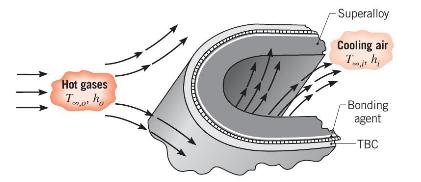The performance of gas turbine engines may be improved by increasing the tolerance of the turbine blades
Question:
The performance of gas turbine engines may be improved by increasing the tolerance of the turbine blades to hot gases emerging from the combustor. One approach to achieving high operating temperatures involves application of a thermal barrier coating (TBC) to the exterior surface of a blade, while passing cooling air through the blade. Typically, the blade is made from a high-temperature superalloy, such as Inconel \((k \approx 25 \mathrm{~W} / \mathrm{m} \cdot \mathrm{K})\), while a ceramic, such as zirconia \((k \approx1.3\mathrm{~W} / \mathrm{m} \cdot \mathrm{K})\), is used as a TBC.

Consider conditions for which hot gases at \(T_{\infty, o}=1700 \mathrm{~K}\) and cooling air at \(T_{\infty, i}=400 \mathrm{~K}\) provide outer and inner surface convection coefficients of \(h_{o}=1000 \mathrm{~W} / \mathrm{m}^{2} \cdot \mathrm{K}\) and \(h_{i}=500 \mathrm{~W} / \mathrm{m}^{2} \cdot \mathrm{K}\), respectively. If a \(0.5-\mathrm{mm}\)-thick zirconia TBC is attached to a 5-mm-thick Inconel blade wall by means of a metallic bonding agent, which provides an interfacial thermal resistance of \(R_{t, c}^{\prime \prime}=10^{-4}\) \(\mathrm{m}^{2} \cdot \mathrm{K} / \mathrm{W}\), can the Inconel be maintained at a temperature that is below its maximum allowable value of \(1250 \mathrm{~K}\) ? Radiation effects may be neglected, and the turbine blade may be approximated as a plane wall. Plot the temperature distribution with and without the TBC. Are there any limits to the thickness of the TBC?
Step by Step Answer:

Fundamentals Of Heat And Mass Transfer
ISBN: 9781119220442
8th Edition
Authors: Theodore L. Bergman, Adrienne S. Lavine




